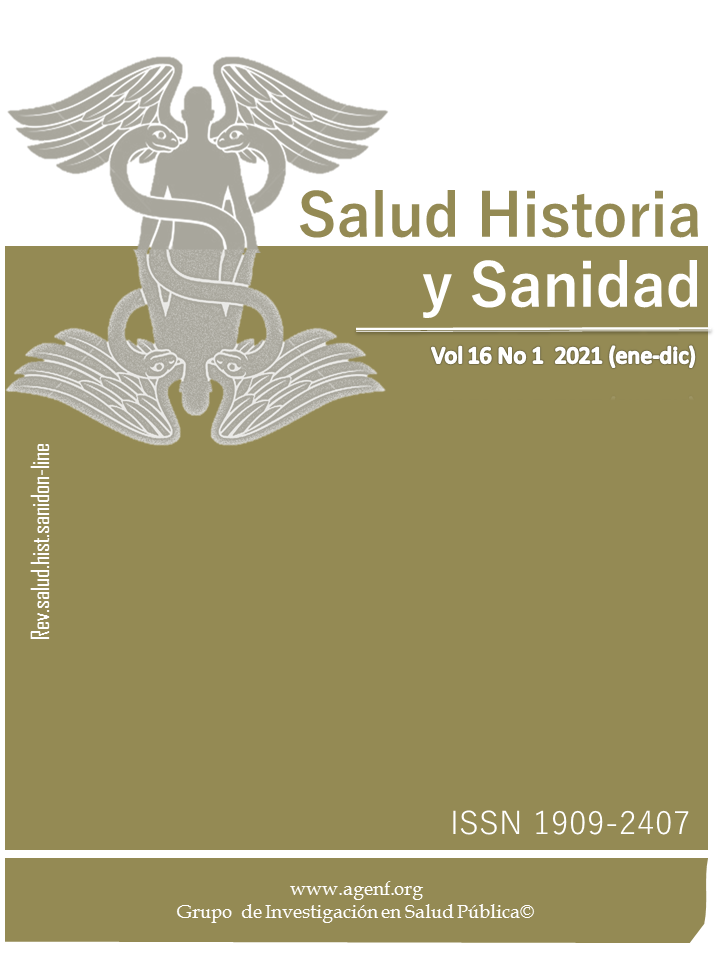Abstract
Soccer requires the use of all energy systems, VO2max is
an important indicator of the aerobic possibilities of athletes,
it integrates multiple organic functions that reflect the level of
conditioning and the player’s state of health. Endurance training
has acquired a fundamental role in planning and programming
in soccer, it has a positive influence on the improvement
of qualities and, therefore, higher performance of the athlete
despite the controversy about the development of aerobic and
anaerobic in young soccer players and their possible interference
with other physical qualities. Target. Analyze the indirect
VO2max of the male under 20 players of the Patriotas Futbol
Club team according to their position on the field of play. Materials
and method. Quantitative and cross-sectional study. The
sample consisted of 28 male soccer players from the sub 20
categories of the Patriotas Futbol Club team, to determine the
indirect VO2max, the Course Navette Test was applied and Leger’s
formula was used to estimate Vo2max of each player based
on their position on the field. of game. Statistic analysis.
For the analysis of the variables, they were treated with SPSS
version 21 software. Results. It can be observed that there are
significant dierences (p 0.05) between groups, both in distance,
Vo2max, speed and in the period. There were no significant
dierences in the height variable between the groups. Conclusions.
Most of the male under-20 footballers of the Patriotas
Futbol Club team presented a Vo2max appropriate for their age
and competitive level. The Leger test contains a determining
and motivational factor for the players participating in the study.
References
Alba, A. (2005). Test funcionales: cineantropometría y prescripci´on del entrenamiento en el deporte y la actividad física. (2 ed.). Colombia: Editorial Kinesis.
Bangsbo, J., Nørregaard, L., Thorsoe, F. (1991). Activity profile of competition soccer. Canadian Journal of Sport Sciences, 16(2), 110-116.
Bassett D., Howley E.T. (1997) Maximal oxygen uptake: Classical versus contemporary viewpoints. Medicine Science Sports and Exercise, 29, 591-603.
Cˆandidoa, V., Queiroz-Sarnaglia, A.J., Perez, A.J., Carletti, L. (2019). Identification of the plateau in maximal oxygen consumption: proposal and application of a new method of analysis. Revista Andaluza de Medicina del Deporte, 12(4), 358-362.
Carranza. (2006). Capacidad aer´obica en estudiantes universitarios. Enero del 2018, de facultad de organización deportiva.
Castagna, C.; Impellizzeri, F. M.; Belardinelli, R.; Abt, G.; Coutts, A.; Chamari, K., D’Ottavio, S. (2006). Cardiorespiratory responses to Yo-yo Intermittent Endurance Test in nonelite youth soccer players. Journal of Strength and Conditioning Research, 20(2), 326–330.
Cooper, K. (1979). El camino del aerobic. Ed. Diana. México.
Gonz´alez Collazos, C. F., Calambas Yotengo, G. A. (2014). Caracterizaci´on antropom´etrica, funcional y motora del equipo pre juvenil de la escuela de fútbol de la Universidad del Valle, con edades de 14 a 15 años (Doctoral dissertation).
Gutiérrez Espinosa, R. A. Rodríguez, J. A. (2009). Caracterización de las capacidades condicionales y perfil antropométrico de los jugadores que integran los clubes de fútbol de Pereira y Dosquebradas categor´ıa Pre-Juvenil 2009. Tesis para ´optar por el título de Profesional en ciencias del deporte y la recreaci´on. Universidad Tecnológica de Pereira. Colombia- Pereira.
Higino, Wonder Sorroche, Alex Falqueiro, Pedro Lima, Yuri Higa, Camila. (2017). Determination of Aerobic Performance in Youth Soccer Players: E ect of Direct And Indirect Methods. Journal of Human Kinetics. 56. 10.1515/hukin-2017-0028.
Ho , J., Wislø , U., Engen, L.C., Kemi, O.J., Helgerud, Med. 36(3):218-21, 2002.
Ho man, J. R., Cooper, J.,Wendell, M., Kang, J. (2004). Comparison of Olympic vs. traditional power lifting training programs in football players. Journal of Strength
Kotzamanidis, C., Chatzopoulos, D., Michailidis, C., Papaiakovou,
G., Patikas, D. The E ect Of A Combined High-Intensity strength and speed training program on
the running and jumping ability of soccer players. Journal of Strength and Conditioning Research. 19(2):369-375, 2005.
Lupton H. (1923). Un an´alisis de los efectos de la velocidad sobre la eficiencia mec´anica del movimiento muscular humano. The Journal of Physiology, 57 (6), 337–353.
MacDougall, J.D. (2005). Evaluaci´on fisiol´ogica del deportista. (3ed). Barcelona, Espa˜na: Editorial Paidotribo.
Metaxas, T. I., Koutlianos, N. A., Kouidi, E. J., Deligiannis, A. P. (2005). Comparative study of field and laboratory tests for the evaluation of aerobic capacity in soccer players. The Journal of Strength Conditioning Research, 19(1), 79-84.
Moreira, S. B. (2008). The Evolution of the Individual Factors Performance in the Elite of theWorld Soccer, between1970 and 1998. Fitness and Performance Journal, 7 (2), p.107-111.
Pasquarelli BN, Santos AL, Frisselli A, Dourado AC, Stanganelli LCR. Relationship between the Bansgsbo Sprint Test with sprint, agility, lower limb power and aerobic capacity tests in soccer players. Revista Andaluza de Medicina del Deporte, 2010; 3(3): 87-91.
Reilly, T. (1996). Aspectos fisiológicos del fútbol. Actualización en Ciencias del Deporte, 4 (13).
Reilly, T., Bangsbo, J., Franks, A. (2000). Anthropometric and physiological predispositions for elite soccer. Journal of sports sciences, 18(9), 669-683.
Sánchez, D., Santalla, A., Candela, J., Leo, F., García, T. (2014). An´alisis de la relaci´on entre el Yo-Yo test y el consumo m´aximo de ox´ıgeno en j j´ovenes jugadores de futbol. Revista Internacional de Ciencias del Deporte.
Silvestre, R.,West, C., Maresh, C. y Kraemer,W. (2006). Body Composition and Physical Performance in Men’s Soccer: A Study of a National Collegiate Athletic Association Division I Team. Journal of Strength and Conditioning Research, 20 (1), 177183.
Slimani M, Nikolaidis PT. Anthropometric and physiological characteristics of male Soccer players according to their competitive level, playing position and age group: a systematic review. Journal of Sports Medicine Physiology and Fitness. 2017 doi: 10.23736/S0022-4707.17.07950-6.
Slimani, M., Znazen, H., Miarka, B., Bragazzi, N. L. (2019). Maximum Oxygen Uptake of Male Soccer Players According to their Competitive Level, Playing Position and Age Group: Implication from a Network Meta-Analysis. Journal of Human Kinetics, 66, 233–245.
Smirmaul, B. P., Bertucci, D. R., Teixeira, I. P. (2013). Is the VO2max that we measure really maximal?. Frontiers in physiology, 4, 203.
Wilmore, J.H., Costill, D.L. (2004). Physiology of sport and exercise. 3rd edition. Human Kinetics, Champaign IL. p. 271-304.

This work is licensed under a Creative Commons Attribution-NonCommercial-NoDerivatives 4.0 International License.
Copyright (c) 2022 Journal Health, History and Sanity

